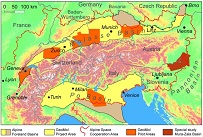GEOMOL

Europe at the beginning of the 21th has to cope with an immense challenge: to meet the European Commission’s ambitious targets for carbon emission reduction renewable energy production has to be strongly upgraded and must be made more efficient and capable for grid energy storage.
The Alpine foreland basins (Po Valley to the south, Molasse Basin to the north of the Alps), due to their geological characteristics, may substantially contribute to tackle this challenges because they offer a significant geothermal potential, a capacity of energy storage produced by renewable sources and geological structures potentially suitable for the storage of gas or sequestered CO2. The evaluation and the use of these subsurface potential must also take account of the possible competing uses (oil and gas production, groundwater resources). Geology and the potentials, resources and natural hazards connected with it do not respect political boundaries.
Investigations on subsurface potentials (geothermal, waters, storage of CO2 and other gases, etc.), therefore, must be guided by geological structures and not by administrative units. To collect and make available reliable three-dimensional geological information, consistent and objective, on the architecture and the characteristics of the subsurface is the essential prerequisite for an integrated planning and a sustainable management of resources, taking into account also the interactions with natural risks.
The GeoMol Project "Assessing subsurface potentials of the Alpine Foreland Basins for sustainable planning and use of natural resources" is funded by the Alpine Space Program 2007-2013 - European Territorial Cooperation, under the priority theme 3 - Environment and Risk Prevention. The project, which includes 14 partners from Austria, France, Germany, Italy, Slovenia and Switzerland, will take place between September 2012 and June 2015.

